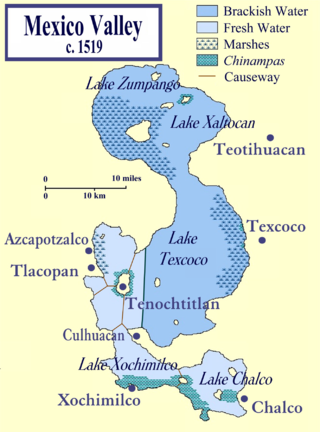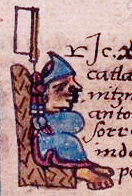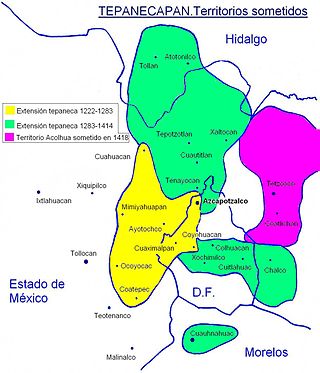
Cuitláhuac or Cuitláhuac was the 10th Huey Tlatoani (emperor) of the Aztec city of Tenochtitlan for 80 days during the year Two Flint (1520). He is credited with leading the resistance to the Spanish and Tlaxcalteca conquest of the Mexica Empire, following the death of his kinsman Moctezuma II.

The Aztecs were a Mesoamerican civilization that flourished in central Mexico in the post-classic period from 1300 to 1521. The Aztec people included different ethnic groups of central Mexico, particularly those groups who spoke the Nahuatl language and who dominated large parts of Mesoamerica from the 14th to the 16th centuries. Aztec culture was organized into city-states (altepetl), some of which joined to form alliances, political confederations, or empires. The Aztec Empire was a confederation of three city-states established in 1427: Tenochtitlan, the capital city of the Mexica or Tenochca, Tetzcoco, and Tlacopan, previously part of the Tepanec empire, whose dominant power was Azcapotzalco. Although the term Aztecs is often narrowly restricted to the Mexica of Tenochtitlan, it is also broadly used to refer to Nahua polities or peoples of central Mexico in the prehispanic era, as well as the Spanish colonial era (1521–1821). The definitions of Aztec and Aztecs have long been the topic of scholarly discussion ever since German scientist Alexander von Humboldt established its common usage in the early 19th century.

Acamapichtli was the first Tlatoani, or king, of the Aztecs of Tenochtitlan, and founder of the Aztec imperial dynasty. Chronicles differ as to the dates of his reign: according to the Codex Chimalpahin, he reigned from 1367 to 1387; according to the Codex Aubin, he reigned from 1376 to 1395; and according to the Codex Chimalpopoca, he reigned from 1350 to 1403.

Huitzilihuitl or Huitzilihuitzin was the second Tlatoani or king of Tenochtitlan. According to the Codex Chimalpahin, he reigned from 1390 to 1415, according to the Codex Aubin, he reigned from 1396 to 1417 and according to the Codex Chimalpopoca, he reigned from 1403 to 1417.

Tlacopan, also called Tacuba, was a Tepanec / Mexica altepetl on the western shore of Lake Texcoco. The site is today the neighborhood of Tacuba, in Mexico City.

The Aztec Empire or the Triple Alliance was an alliance of three Nahua city-states: Mexico-Tenochtitlan, Tetzcoco, and Tlacopan. These three city-states ruled that area in and around the Valley of Mexico from 1428 until the combined forces of the Spanish conquistadores and their native allies who ruled under Hernán Cortés defeated them in 1521.

Don Diego de Alvarado Huanitzin was a 16th-century Nahua noble. A grandson of Axayacatl, Nephew of tlatoani Moctezuma II. He was initially the tlatoani (ruler) of Ecatepec before becoming tlatoani of Tenochtitlan, as well as its first governor under the colonial Spanish system of government.

The Aztecs were a Pre-Columbian Mesoamerican people of central Mexico in the 14th, 15th, and 16th centuries. They called themselves Mēxihcah.

The Tepanecs or Tepaneca are a Mesoamerican people who arrived in the Valley of Mexico in the late 12th or early 13th centuries. The Tepanec were a sister culture of the Aztecs as well as the Acolhua and others—these tribes spoke the Nahuatl language and shared the same general pantheon, with local and tribal variations.
Culhuacan was one of the Nahuatl-speaking pre-Columbian city-states of the Valley of Mexico. According to tradition, Culhuacan was founded by the Toltecs under Mixcoatl and was the first Toltec city. The Nahuatl speakers agreed that Culhuacán was the first city to give its rulers the title of "speaker" (tlatoani). In the sixteenth century following the Spanish conquest of the Aztec Empire, Culhuacan was incorporated into colonial New Spain and called a pueblo, but in local-level documentation in Nahuatl, residents continued to use the designation altepetl for their settlement.

Don Luis de Santa María Nanacacipactzin, also known as Cipac, was the last tlatoani ("king") of the Nahua altepetl of Tenochtitlan, as well as its governor (gobernador) under the colonial Spanish system of government. The previous ruler Cristóbal de Guzmán Cecetzin having died in 1562, Nanacacipactzin was installed on September 30, 1563, and ruled until his death on December 27, 1565.
Chālco was a complex pre-Columbian Nahua altepetl or confederacy in central Mexico. It was divided into the four sub-altepetl of Tlalmanalco/Tlacochcalco, Amaquemecan, Tenanco Texopalco Tepopolla and Chimalhuacan-Chalco, which were themselves further subdivided into altepetl tlayacatl, each with its own tlatoani (king). Its inhabitants were known as the Chālcatl (singular) or Chālcah (plural).

The Codex Azcatitlan is an Aztec codex detailing the history of the Mexica and their migration journey from Aztlán to the Spanish conquest of the Aztec Empire. The exact date when the codex was produced is unknown, but scholars speculate it was crafted some time between the mid-16th and 17th centuries. The name of this important Mexica pictorial manuscript was suggested by its first editor, Robert H. Barlow, who erroneously interpreted the anthill on page 2 as the glyph for “Aztlán.” In the Bibliothèque nationale de France, where it is housed, it is known as Histoire mexicaine, [Manuscrit] Mexicain 59–64.
Hernando (de) Alvarado Tezozómoc was a colonial Nahua noble. He was a son of Diego de Alvarado Huanitzin and Francisca de Moctezuma. Tezozómoc worked as an interpreter for the Real Audiencia. Today he is known for the Crónica Mexicayotl, a Nahuatl history.

Antonio Valeriano was a colonial Mexican, Nahua scholar and politician. He was a collaborator with fray Bernardino de Sahagún in the creation of the twelve-volume General History of the Things of New Spain, the Florentine Codex, He served as judge-governor of both his home, Azcapotzalco, and of Tenochtitlan, in Spanish colonial New Spain.

Tlatelolco was a pre-Columbian altepetl, or city-state, in the Valley of Mexico. Its inhabitants, known as the Tlatelolca, were part of the Mexica, a Nahuatl-speaking people who arrived in what is now central Mexico in the 13th century. The Mexica settled on an island in Lake Texcoco and founded the altepetl of Mexico-Tenochtitlan on the southern portion of the island. In 1337, a group of dissident Mexica broke away from the Tenochca leadership in Tenochtitlan and founded Mexico-Tlatelolco on the northern portion of the island. Tenochtitlan was closely tied with its sister city, which was largely dependent on the market of Tlatelolco, the most important site of commerce in the area.

Chimalpilli II was a Tlatoani (ruler) of the Nahua altepetl (city-state) Ecatepec, in 16th-century Mesoamerica.
Tlapalizquixochtzin was an Aztec noblewoman and Queen regnant of the Aztec city of Ecatepec. She was also a consort of Moctezuma II.
Quecholcohuatl was a Chalcan musician. He was known for making peace between his native altepetl of Chalco and Tenochtitlan by serenading its Tlatoani, Axayacatl, in 1479.












